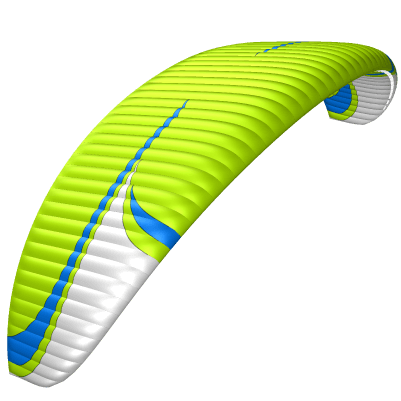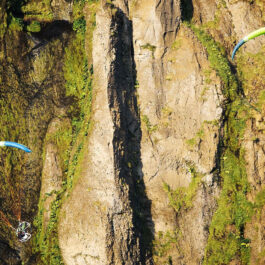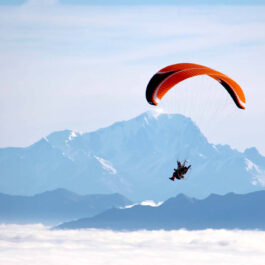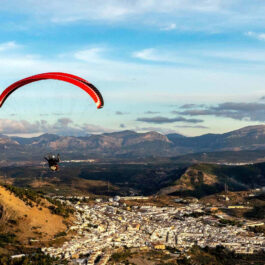NIVIUK R-Bus
THE GREAT TRAVELLER
The best part of an adventure is to share it. This is the first Niviuk tandem paramotor wing for all types of trikes and foot-launched dual PPGs.
PPG
EN 926-1 / DGAC
Description
The weight of a unique experience
The R-Bus has the capacity to carry loads up to 500 kg and it is eager to discover new areas and flying experiences. Amazing strength translates into stability and comfort for both pilot and passenger.
Easy to control in the air and on the ground
Solid but agile, it also permits a uniform inflation and rapid and progressive wing loading. Efficiency is assured from the first to the last moment, resulting in takeoffs and landings that are simple, fast and accurate.
Niviuk DNA
Like all Niviuk wings, the R-Bus is characterised by performance, quality and great flight behaviour. Experience and share all the benefits of this new wing concept. A great traveller ready for great journeys.
All about R-Bus ▼
The R-Bus is the first Niviuk tandem paramotor wing designed for use with a trike and it can carry loads up to 500 kilograms. Also suitable for lighter rigs and foot-launched PPG tandems, the new R-Bus was conceptualised to become the ideal tool for both professional and recreational flights.
It is a highly robust, stable and durable wing. It also features excellent wing loading and energy retention for comfortable, safe takeoffs and landings for both pilot and passenger.
The reinforced internal structure, as well as the optimised line configuration, means the load is perfectly distributed and balanced and this makes this wing capable of carrying up to 500 kg. Due to their lightweight nature, the incorporation of Nitinol rods in the profile also reduces the inertia and means a stiffer, crease-free leading edge to reduce parasitic drag.
However, the first step to an excellent flight experience is a good takeoff. The design of the line distribution permits a uniform inflation and the wing rises quickly, accurately and without the tendency over-shoot. A perfectly controllable launch phase is made possible thanks to the A Assist System, which allows the pilot to fix the A-risers to the trike to keep their hands free to comfortably handle the brake controls. On the other hand, the increased lift generated by the aerofoil enables excellent wing loading, and as a result neither long distances, high speeds or high engine power are required during takeoff. Thanks to this, neither high speed nor high engine power are required during takeoff. The R-Bus allows both pilot and passenger to quickly and easily take flight, even in less favourable conditions.
The comfort factor is also reflected in the degree of manoeuvrability of the wing. Its dual steering system enables the pilot to steer and turn efficiently without requiring much effort: the wing has both the main brake and a high-speed tip steering which allows the pilot to turn without pulling the brake, avoiding profile deformation and, as a result, a decrease of speed and performance. Also, it is a very efficient tool to compensate for the natural equal and opposite effect caused by engine inertia or torque.
The R-Bus is also equipped with a high efficiency profile, offering excellent top and cruising speeds. With the new built-in Trim Adjustor, the pilot can accurately control both the direction and speed, regardless of wing-loading.
Another strength of the R-Bus is its high degree of stability (also with light loads). Efficient glide means reduced fuel consumption and it gives the wing excellent energy retention and easy roundout for soft landings. In the case of engine failure, the reduced sink rate is big bonus for safety (-2.5 m/s for a wing-loading of 420 kg).
Suitable for a wide range of paramotors and trikes, the R-Bus is available in four sizes: 31 & 34 m2 (ideal for light trikes, windy areas or foot-launched takeoffs with moderate wind) and 37 & 40 m2 (perfect for heavier trikes).
Share and enjoy all the advantages of this new wing with pure Niviuk DNA.
In case of a trike designed to have elevated hang points, the R-Bus accessories include extra brake lines and the high speed tip is one meter longer. The pilot should exchange and adjust these as required.
The fabric, lines, risers and wing size can all be changed to customise and adapt the model to suit your needs and preferences. Contact us and we will personally explore all the possibilities.
3D Leading Edge
Adding an extra seam to the leading edge on the span axis of the glider helps to shape a compact 3D profile and have better connections to the new 3DP front panel’s layout.
3D Pattern Cut Optimization
The latest glider generation requires a new pattern design and an optimized fabric cutting process based on a 3D technology.
RAM Air Intake
Evolution and constant improving in all our products is the essence of the DNA of Niviuk’s R&D team. Thanks to the new technologies created over recent years, we have conceived new and more evolved and higher performing gliders. In this context the RAM Air Intake technology should be pointed out.
Reflex System Profile
The highly efficient Reflex System Profile (RSP) unlike conventional reflex designs requires less engine power to achieve greater thrust, thus resulting in lower fuel consumption, more autonomy and higher overall motor efficiency.
Structured Leading Edge
The SLE provides more rigidity and stability along the span of leading edge but also allows full flexibility along the both the vertical and horizontal axis of each open cell. The SLE ensures ease of movement on the ground and high security in the air during turbulence and whilst flying at speed.
Titanium Technology
Constantly innovating, we always are on the hunt, looking for the latest and best materials to helps us design optimal products. For this reason, and after an extensive evaluation of its benefits and qualities, we decided to be the firsts manufacturer to use Nitinol in our glider line.
SPECIFICATIONS
| R-BUS | 31 | 34 | 37 | 40 | ||
| Cells | Number | 55 | 55 | 55 | 55 | |
| Closed | 8 | 8 | 8 | 8 | ||
| Box | 35 | 35 | 35 | 35 | ||
| Flat | Area | m2 | 31 | 34 | 37 | 40 |
| Span | m | 12.94 | 13.55 | 14.14 | 14.7 | |
| Aspect Ratio | 5.4 | 5.4 | 5.4 | 5.4 | ||
| Projected | Area | m2 | 26.97 | 29.58 | 32.19 | 34.8 |
| Span | m | 10.56 | 11.06 | 11.54 | 12 | |
| Aspect Ratio | 4.14 | 4.14 | 4.14 | 4.14 | ||
| Flattening | % | 15 | 15 | 15 | 15 | |
| Chord | Maximum | m | 2.97 | 3.11 | 3.24 | 3.37 |
| Minimum | m | 0.65 | 0.68 | 0.71 | 0.74 | |
| Average | m | 2.40 | 2.51 | 2.62 | 2.72 | |
| Lines | Total meters | m | 398 | 417 | 426 | 444 |
| Height | m | 7.7 | 8.06 | 8.41 | 8.75 | |
| Number | 288 | 288 | 288 | 288 | ||
| Main | 3 1/5/3/2 | 3 1/5/3/2 | 3 1/5/3/2 | 3 1/5/3/2 | ||
| Risers | Number | 4 | A A’/B/C/D | A A’/B/C/D | A A’/B/C/D | A A’/B/C/D |
| Trimmers | mm | 105 | 105 | 105 | 105 | |
| Accelerator | NO | NO | NO | NO | ||
| Course Correction | YES | YES | YES | YES | ||
| Top Speed | 350kg | km/h | 74 (±2) | 73(±2) | 72(±2) | 71(±2) |
| Min. Sink | 350kg | m/s | 1.6 | 1.6 | 1.6 | 1.6 |
| Total weight in flight | Minimum | kg | 100 | 120 | 150 | 210 |
| Maximum | kg | 410 | 440 | 470 | 500 | |
| Glider weight | kg | 6.6 | 7.1 | 7.6 | 8.1 | |
| Certification | 8G max. 328kg | EN 926-1 | EN 926-1 | EN 926-1 | EN 926-1 | |
| 5,25G max. 500kg | DGAC | DGAC | DGAC | DGAC |
Additional information
| Weight | 50 oz |
|---|---|
| Color | Rocket, Mint |
| Size | 31, 34, 37, 40 |





